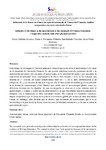Influencia de la Danza en el autoconcepto del alumnado de Educación Primaria: análisis comparativo con otras actividades físicas

Use este enlace para citar
http://hdl.handle.net/2183/22791
Excepto si se señala otra cosa, la licencia del ítem se describe como Atribución-NoComercial-SinDerivadas 3.0 España
Colecciones
Metadatos
Mostrar el registro completo del ítemTítulo
Influencia de la Danza en el autoconcepto del alumnado de Educación Primaria: análisis comparativo con otras actividades físicasTítulo(s) alternativo(s)
Influence of the dance in the autoconcepto of the alumnado of primary education: comparative analysis with other physical activitiesFecha
2017Cita bibliográfica
Sportis, 2017, 3 (3):554-568 ISSN: 2386-8333
Resumen
[Resumen] Este trabajo de investigación pretende analizar la relación que existe entre el autoconcepto y la danza en el alumnado de Educación Primaria. Se han querido relacionar estas dos cuestiones debido a la importancia que tienen, por una parte, el autoconcepto en la identidad del sujeto y por otra parte, la realización de actividad física, concretamente la danza. Para llevarlo a cabo, se ha evaluado una muestra de 74 niños/as, de edades comprendidas entre los 7 y los 12 años, pertenecientes a un colegio (n=45) y dos escuelas de danza de Vigo (n=29). El instrumento de medida que se ha utilizado es la Escala de Autoconcepto (Piers Harris), que valora tanto el autoconcepto global, como sus diferentes dimensiones. La finalidad de esta investigación es observar si existe relación entre el autoconcepto y la danza y cuáles son las dimensiones en las que ésta obtiene mayores puntuaciones, comparar con la realización de otras actividades físicas. Tras analizar los resultados obtenidos, hemos comprobado que la danza no mejora el autoconcepto global por encima de otras actividades físicas, sin embargo, cabe destacar que se observa una dimensión del autoconcepto que sí se ve favorecida por la práctica de la danza, concretamente, la felicidad-satisfacción, en la cual se valora la autoestima del sujeto. [Abstract] This research work pretends to analyse the relationship between the self-concept and the dance in the students of Primary Education. We wanted to relate these both questions because of its importance, on the one hand, the self-concept in the identity of the individual and, on the other hand, doing physical activity, specifically, dance, in the young people. To carry out this research, we have evaluated a sample of 74 children between 7 and 12 years from one school (n=45) and two dance schools in Vigo (n=29). We use the Self-Concept Questionnaire (Piers Harris), which values the global self-concept and the dimensions of the self-concept. The purpose of this research is to check if there is some kind of relationship between the self-concept and dance, and to know what dimensions of the self-concept get more score in dance than in other physical activities. We have analysed the results and verified that dance does not improve the global self-concept more than other physical activities; nevertheless, it is remarkable that there is a dimension of self-concept that gets high score in connection with practicing dance, specifically, the happiness-satisfaction, which values the self-esteem of the individual.
Palabras clave
Autoconcepto
Danza
Actividad física
Alumnado de Educación Primaria
Escala de Autoconcepto (Piers Harris)
Self-concept
Dance
Physical activity
Students of Primary Education
Self-Concept Questionnaire (Piers Harris)
Danza
Actividad física
Alumnado de Educación Primaria
Escala de Autoconcepto (Piers Harris)
Self-concept
Dance
Physical activity
Students of Primary Education
Self-Concept Questionnaire (Piers Harris)
Derechos
Atribución-NoComercial-SinDerivadas 3.0 España
ISSN
2386-8333






